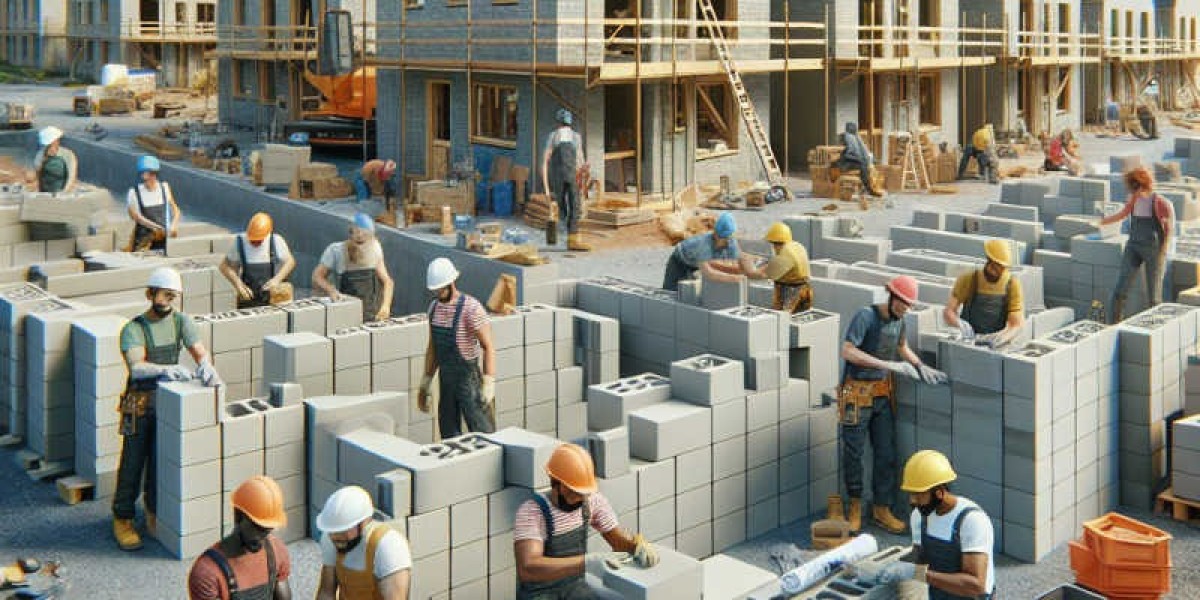Benefits of Choosing Expanded Clay Blocks for Your Home
Opting for expanded clay blocks in the construction of your home offers a myriad of advantages that cater to both efficiency and sustainability. Experts in the field of construction and sustainable building practices often highlight the thermal insulation properties of these blocks, which significantly contribute to energy savings throughout the year. This characteristic not only ensures a comfortable living environment but also leads to a reduction in heating and cooling costs, making it a financially savvy choice for homeowners. Additionally, the lightweight nature of expanded clay blocks simplifies the construction process, allowing for quicker project completion times without compromising on structural integrity.
From an environmental perspective, choosing expanded clay blocks is a step towards greener construction methodologies. These blocks are produced from natural clay, which is expanded at high temperatures to create a lightweight, porous aggregate. This process results in a building material that is not only resource-efficient but also recyclable, contributing to the reduction of construction waste. Experts also point out the excellent fire resistance and sound insulation properties of expanded clay blocks, making them an ideal choice for homeowners prioritising safety and privacy. With these benefits in mind, it's clear why an increasing number of architects and builders recommend expanded clay blocks for residential construction projects.
Understanding the Thermal Insulation Properties of Expanded Clay Blocks
The thermal insulation performance of expanded clay blocks stands as a pivotal factor in their growing popularity for modern construction projects. These blocks, known for their lightweight and porous nature, offer an exceptional balance between durability and insulation efficiency. The inherent air pockets within the clay contribute significantly to reducing heat transfer, making buildings more energy-efficient and comfortable throughout the year. This characteristic not only enhances the living environment but also contributes to substantial energy savings over time.
When considering the construction of energy-efficient homes, the specific thermal conductivity of the chosen materials plays a crucial role. Expanded clay blocks exhibit a low thermal conductivity, typically ranging between 0.09 to 0.20 W/(m·K), which underscores their ability to act as a robust barrier against heat loss. This property ensures that indoor temperatures remain stable, irrespective of external weather conditions, thereby reducing the reliance on heating and cooling systems. The result is a marked improvement in the building's carbon footprint, aligning with contemporary environmental sustainability goals.
Moreover, the adaptability of expanded clay blocks to various climatic conditions further elevates their appeal. Whether in regions experiencing extreme cold or those subjected to high temperatures, these blocks maintain their insulation performance without degradation over time. This durability, coupled with the ease of installation, makes expanded clay blocks an attractive option for builders and architects aiming to meet stringent energy efficiency standards. By integrating these blocks into construction projects, developers can achieve a harmonious balance between eco-friendliness, cost-effectiveness, and occupant comfort, thereby setting a new benchmark in sustainable building practices.
Step-by-Step Guide to Building with Expanded Clay Blocks
Embarking on a construction project with expanded clay blocks requires meticulous planning and execution. This guide aims to streamline the process, ensuring a robust and energy-efficient outcome. Preparation is paramount; hence, the initial step involves securing all necessary permits and ensuring the site is fully prepped for construction. Following this, the construction journey can be broken down into several key phases:
- Foundation Preparation: Lay a solid foundation tailored to the weight and structure of expanded clay blocks. This often involves digging trenches, laying a bed of gravel, and pouring a concrete foundation.
- Layout Planning: Carefully plan the layout of the walls, taking into account door and window placements. This step is crucial for ensuring a seamless construction process.
- First Course Installation: Begin laying the first course of blocks carefully, using a spirit level to ensure all blocks are perfectly aligned and level.
- Mortar Application: Apply a layer of mortar specifically designed for expanded clay blocks between each course, ensuring strong adhesion and structural integrity.
- Reinforcement: Integrate reinforcement bars or mesh at specified intervals to enhance the wall's strength, particularly in seismic-prone areas.
- Services Installation: Concurrently work on the installation of electrical and plumbing services, making sure these are well integrated within the wall cavities before sealing.
- Insulation and Finishing: Apply external and internal finishes, paying special attention to thermal insulation properties to maximise the energy efficiency of the building.
Adhering to these steps, while ensuring quality control at each phase, will result in a durable and energy-efficient structure built with expanded clay blocks. Remember, the success of the project hinges on detailed planning and precise execution.
Cost Analysis: Investing in Expanded Clay Block Construction
Investing in expanded clay block construction presents a financially savvy option for modern builders and homeowners alike. This method of construction is renowned for its cost-effectiveness and energy efficiency, making it an attractive choice for those looking to build sustainable and budget-friendly homes. Key points to consider in the cost analysis include:
- Initial Investment: While the upfront cost of expanded clay blocks can be higher than traditional materials, the long-term savings on energy bills and maintenance can offset these initial expenses.
- Energy Efficiency: The inherent thermal insulation properties of expanded clay blocks significantly reduce heating and cooling costs, contributing to substantial savings over the lifespan of the building.
- Durability: These blocks are highly durable and resistant to fire, moisture, and pests, leading to lower repair and replacement costs.
- Construction Speed: The lightweight nature and ease of installation of expanded clay blocks can accelerate construction timelines, reducing labour costs and allowing for quicker occupancy.
Considering these factors, it becomes evident that expanded clay block construction is not only an environmentally responsible choice but also a financially astute investment for those seeking long-term value.
Design Flexibility and Aesthetic Appeal of Expanded Clay Block Homes
Expanded clay blocks offer unparalleled design flexibility and aesthetic appeal in the construction of homes. These materials allow architects and builders to push the boundaries of traditional design, enabling the creation of unique, energy-efficient, and visually striking residences. The lightweight nature of expanded clay blocks, coupled with their impressive structural integrity, means that they can be used to achieve a wide range of architectural styles, from sleek and modern to rustic and traditional. Furthermore, the surface texture of these blocks lends a distinctive character to buildings, enhancing their visual appeal and seamlessly blending with various landscapes.
When considering the design possibilities with expanded clay block homes, it's essential to note the following advantages:
- Customisation and Creativity: The blocks can be easily shaped, cut, and adjusted, allowing for custom designs and innovative architectural solutions.
- Colour and Texture Variety: Expanded clay blocks come in a range of colours and textures, offering numerous options for facade treatments and interior finishes.
- Integration with Other Materials: These blocks can be effectively combined with wood, glass, and metal, providing endless possibilities for creating diverse and attractive designs.
These aspects significantly contribute to the aesthetic appeal and functionality of homes built with expanded clay blocks, making them a preferred choice for many architects and homeowners seeking both beauty and practicality in their construction projects.
Ensuring Durability: Best Practices for Expanded Clay Block Construction
Ensuring the longevity and durability of structures built with expanded clay blocks hinges on adhering to best practices throughout the construction process. One of the critical factors is the quality of the blocks themselves. It is essential to select blocks that meet the relevant standards and specifications for density, moisture content, and thermal conductivity. Proper handling and storage of the blocks on-site to prevent damage before use is equally important. Additionally, the use of appropriate mortar, designed specifically for expanded clay block construction, can significantly impact the overall integrity and thermal efficiency of the finished structure. This mortar should have the right adhesive properties and flexibility to accommodate the lightweight nature of the blocks without compromising on strength.
When comparing expanded clay block construction to traditional materials like concrete and brick, several advantages become apparent. The following table illustrates key differences:
Criteria | Expanded Clay Blocks | Concrete Blocks | Brick |
|---|---|---|---|
Thermal Insulation | High | Medium | Low |
Weight | Light | Heavy | Medium |
Construction Speed | Fast | Slow | Medium |
Cost | Medium | Low | High |
This comparison underscores the superior thermal insulation and lighter weight of expanded clay blocks, contributing to faster construction times and potentially lower long-term energy costs. However, it's crucial to balance these benefits against the initial material costs and consider the specific requirements of the construction project. Employing skilled labour experienced in working with expanded clay blocks can further enhance the durability and efficiency of the build, ensuring that the full potential of this innovative material is realised https://stroydomcrimea.com/.
Comparing Expanded Clay Blocks with Traditional Building Materials
When considering the construction of new homes, the choice of materials plays a pivotal role in determining not only the aesthetics but also the durability and energy efficiency of the building. Expanded clay blocks have emerged as a formidable alternative to traditional building materials, offering a unique blend of benefits that cater to modern construction needs. These lightweight blocks are manufactured by expanding clay at high temperatures, resulting in a porous structure that provides excellent insulation properties.
Among the advantages of using expanded clay blocks, several key points stand out when compared to more traditional materials such as concrete, brick, or wood:
- Enhanced thermal insulation: The inherent porosity of expanded clay blocks makes them highly efficient at insulating buildings, potentially reducing heating and cooling costs.
- Improved fire resistance: Unlike wood, expanded clay blocks are non-combustible, offering an added layer of safety to structures.
- Lightweight construction: Their lightweight nature facilitates easier and quicker construction, reducing labor costs and time on site.
- Sound insulation: The porous structure also contributes to effective sound insulation, creating quieter indoor environments.
- Eco-friendly: Made from natural clay, these blocks are environmentally friendly, contributing to sustainable construction practices.
While the benefits of expanded clay blocks are compelling, it is crucial to weigh them against the specific requirements of each project. Traditional materials may still hold the upper hand in certain scenarios, such as when structural load-bearing capacity is a primary concern, or when the aesthetic preference leans towards materials like natural stone or brick. However, for projects where energy efficiency, fire safety, and speed of construction are paramount, expanded clay blocks offer a competitive and innovative solution that aligns with contemporary construction trends and sustainability goals.
Sustainable Building: The Environmental Advantages of Expanded Clay Blocks
Delving into the realm of sustainable construction, the use of expanded clay blocks stands out for its remarkable environmental benefits. These lightweight yet sturdy materials are championed for their energy efficiency and low carbon footprint, making them an ideal choice for eco-conscious builders and homeowners alike. Not only do they provide excellent thermal insulation, reducing the need for artificial heating and cooling, but their production process also consumes significantly less energy compared to traditional building materials, further underscoring their sustainability credentials.
Moreover, expanded clay blocks contribute to healthier living environments. Their ability to regulate humidity levels and ensure good indoor air quality positions them as a superior option for residential construction. The material's inherent properties also include fire resistance and sound insulation, enhancing the safety and comfort of dwellings. By choosing expanded clay blocks, builders are not only making a decision that benefits the planet but also creating homes that stand the test of time, both structurally and environmentally. This aligns perfectly with the growing demand for sustainable living solutions that do not compromise on quality or performance.
Frequently Asked Questions
Can expanded clay blocks be used for load-bearing walls?
Yes, expanded clay blocks are structurally robust and can be used for constructing load-bearing walls. Their high strength-to-weight ratio makes them suitable for both exterior and interior walls in residential buildings.
How do expanded clay blocks contribute to fire resistance in buildings?
Expanded clay blocks offer excellent fire resistance due to their inorganic composition and dense structure. They can withstand high temperatures without compromising their structural integrity, providing an added layer of safety to buildings.
Are there any special tools required for constructing with expanded clay blocks?
No special tools are required for constructing with expanded clay blocks. Standard masonry tools such as trowels, levels, and saws for cutting the blocks to size are typically sufficient, making the construction process straightforward and accessible.
How do expanded clay blocks perform in seismic zones?
Expanded clay blocks perform well in seismic zones due to their lightweight nature and good structural integrity. Their flexibility and strength help in absorbing and dissipating seismic energy, reducing the risk of major structural damage during earthquakes.
Can the interior and exterior surfaces of expanded clay block walls be finished in any special way?
Yes, the surfaces of expanded clay block walls can be finished with a wide variety of materials including plaster, paint, or cladding, depending on the desired aesthetic and functional requirements. This versatility allows for creative freedom in both interior and exterior design.







